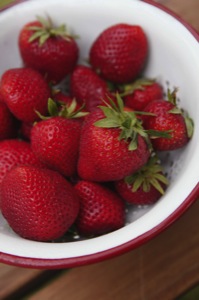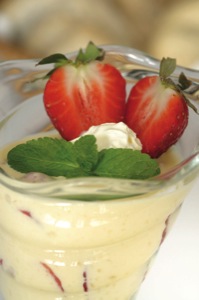
I may be past my prime – but from now until July, strawberries will be in theirs. Of course they are bought with good intentions but probably not a wealth of ideas. It’s just one of those items that look so good in the market that one wants to buy, and then ends up growing mold in the back of the fridge.
Eating the berries raw becomes boring as does adding them to your yogurt, smoothie or cereal. Identifying the key flavors and (as it may seem) odd additions will bring these banal berries to the center of everyone’s focus.
Strawberries are grouped in the rose family and have been grown in the Americas and Europe for centuries. Through careful cultivation and crossbreeding, commercial strawberries are very hearty and flavorful depending on their maturity and upbringing. But caveat emptor, strawberry plants that are purchased for cultivation from your local nurseries are often susceptible to disease and fruits sold in the market vary in flavor depending on size, ripeness and variety-type.
Whether you decide to dice, slice or otherwise heat the component, strawberries are there for the consumer.
Aside from a bowl of the fresh cut fruit, strawberries can be put through a variety of processes that range dramatically in their degree of effort. In abundance, the fruit can be preserved for those lovers of jelly and jams. The quintessential strawberry pie is presented at most July 4 functions with the addition of blueberries and whipped cream making a red, white and blue star. Or, the maceration of the berry which affords a greater abundance of preparation and technique.
Maceration is the use of osmosis to extract the liquids of a solute (the solid component) into the solvent (the liquid component) or more generally speaking, sprinkling the berries with either sugar or salt and allowing the mixture to equilibrate in its own juices. Osmosis is the natural movement of water to an adjacent environment in which less water molecules are present.
In this case, the water from the berries moves to the surface while the sugar replaces the water content of the berry, leaving an amazingly sweet and flavored liquid to use to your benefit and a berry that has been naturally softened and prepared for the palate.
Try using a more Mediterranean flare of raw fruit with volcanic sea salt as a starter to your meal or incorporate balsamic vinegar as your solute for an interesting finish. But, as always do your research and present what is there for the taking.
bobby’s recipe
Rhubarb sabayon with balsamic macerated strawberries
Although this is not the traditional method of making a sabayon, it streamlines the process very nicely using a counter appliance. Once you have made it a few times, you may choose to adjust the flavors to taste.
This recipe will serve ten people liberally.

2 pints of strawberries
1/4 cup balsamic vinegar
1-3/4 cups sugar
1/2 pound of rhubarb
1/4 cup champagne
1-1/2 cups of heavy cream
6 large egg yolks
1/4 cup water
First, chop the strawberries and macerate in the balsamic vinegar and 1/2 cup sugar for at least one hour. Drain juices from the berries and reserve all.
Chop the rhubarb into 1/4-inch slices and sauté in the champagne and 1/2 cup of sugar until it has become completely softened (about 15 minutes). Puree with an immersion blender or food processor and set aside.
Whip the heavy cream to a medium peak and chill in the refrigerator until needed. (If using a counter appliance, remove the whipped cream to a separate bowl to refrigerate and clean the bowl for further use.)
Separate the egg yolks and beat until pale (about 5 minutes).

Bring 3/4 cup sugar plus the water to a boil in a small saucepan. Continue to boil until it has reached the soft ball stage (235 degrees Fahrenheit if using a candy thermometer) or about 4 minutes on a high boil.
On low speed, slowly add the sugar mixture into the egg yolks. Once added, increase the speed to medium low and beat until light pale (10 minutes). Reduce the speed to low and add 1/4 cup reserved strawberry-balsamic liquid. Remove from the appliance and fold in the rhubarb puree.
Add a quarter of the beaten whipped cream to the yolk-fruit mix and stir until combined. Dump in the rest of the whipped cream, switch to a large rubber scraper and fold in the remaining whipped cream. Refrigerate until ready for use.
To serve, distribute the macerated strawberries evenly between your serving dishes. Spoon a healthy portion of the sabayon on top, then garnish with a few more strawberries and a sprig of mint.









